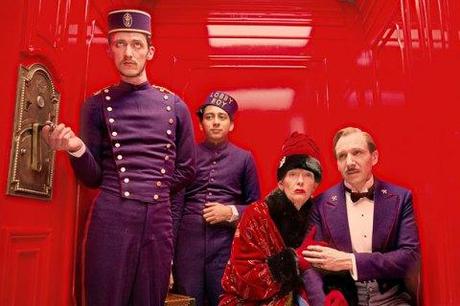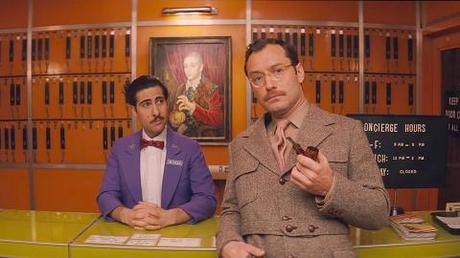
by Steve Habrat
By this point, you know if you’re a proud member of the Wes Anderson fan club. After films like Bottle Rocket, Rushmore, The Royal Tenebaums, The Life Aquatic with Steve Zissou, The Darjeeling Limited, The Fantastic Mr. Fox, and Moonrise Kingdom, you know if you’ve developed a taste for his meticulously organized frames, quirky casts of characters, dry sense of humor, and surprisingly touching dramatics. If you’re one that hasn’t been tickled by Anderson’s cinematic efforts, don’t expect anything to change with The Grand Budapest Hotel, which finds the auteur indulging his whimsical artistry like a kid in a candy store. With all of the usual traits in place, Anderson sends the audience spiraling through a small slice of history—one fashioned from the winking cartoonish touches that Anderson has become noted and celebrated for. While this zany murder mystery is contagiously colorful and cute even in its raunchier moments, The Grand Budapest Hotel is a fuzzy tribute to storytelling, and a sugary tribute to classic slapstick comedy of years past presented to the viewer in 1.33 aspect ratio, common in silent cinema, which appears to be a major influence here. And then there is his cast, a list bursting at the seams with fresh and familiar faces ready to take a big bite out of the oddball creations that Anderson has scribbled up for them.
The Grand Budapest Hotel tells the story of Monsieur Gustave H (played by Ralph Fiennes), the beloved concierge of the magnificent Grand Budapest Hotel, nestled in the snowy mountains of the Republic of Zubrowka. The tale picks up in 1932, with young lobby boy Zero Moustafa (played by Tony Revolori) arriving at The Grand Budapest Hotel and having his first encounters with Gustave H. It turns out that Gustave H was carrying on an affair with a wealthy elderly woman named Madame D (played by Tilda Swinton), who, while visit Gustave H, reveals that she has a premonition that something bad is going to happen. Despite Madame D’s concerns, Gustave H laughs off her premonition, but a few weeks later, Madame D turns up dead under mysterious circumstances. Together, Gustave H and Zero travel to Madame D’s home, where her will is read to a house full of grieving friends and family members. Much to the horror of the guests, Madame D’s will states that she is leaving him a coveted painting called “Boy with Apple,” something that enraged her son, Dmitri (played by Adrien Brody), who vows to come after Gustave H. After making off with “Boy with Apple” and returning to the hotel, things get worse for Gustave H when authorities led by Inspector Henckels (played by Edward Norton) arrive to arrest him for the death of Madame D. Stuck behind bars and with Zubrowka on the brink of war, Gustave H races to escape from prison and prove his innocence with the help of Zero and some unlikely inmates. Meanwhile, a shadowy assassin called J.P. Jopling (played by Willem Dafoe) closes in on Gustave H and those closest to him.

There isn’t a shot in The Grand Budapest Hotel that isn’t littered with Anderson’s cinematic fingerprints. Nearly each and every frame is neatly arranged down to the fussy tilts of a pencil or the messy stack of legal documents. It’s unmistakably Anderson to the point where if you scrubbed his name from the credits, it wouldn’t take the audience long to figure out that it sprouted from his distinct imagination. There are the tracking shots that explore the inside of The Grand Budapest Hotel as if someone sliced it down the center and peered into it like a dollhouse. There are also the glaringly artificial miniatures, which Anderson presents with his expected winks and grins. Though what sets The Grand Budapest Hotel apart from other Anderson fare is the nods to classic cinema, particularly silent slapstick comedies. The Grand Budapest Hotel could be muted and converted to black and white, have intertitles placed strategically throughout, and the film would work marvelously as a silent comedy. There are also a number of chase sequences throughout the film, the most outstanding—and vaguely Hitchcockian/German Expressionist—is a shadowy game of cat-and-mouse through a museum between Dafoe’s vampiric thug J.P. Jopling and Jeff Goldblum’s lawyer, Deputy Vilmos Kovacs. It’s the highlight of the picture, followed closely by a snowy ski chase that keeps you doubled over in laughter over how preposterous the action is.
As usual, Anderson enlists the help of an ensemble cast, many of which will be familiar to Anderson aficionados. The newcomer here is Fiennes, who takes great pleasure in applying his gentlemanly demeanor to Gustave H, the flamboyant concierge who sleeps with elderly woman, gags at the thought of drinking cheap wine, and is bound-and-determined not to become the “candyass” in prison. Fiennes is exquisite, but hot on his coattails is Dafoe, who excels in the role of the stocky assassin J.P. Jopling, a brick of a man who sports skull rings on each one of his fingers and mercilessly tosses cats out of windows. Other standouts include Norton’s dweebie Inspector Henckles, the barely-recognizable Swinton as the elderly Madame D (she’s basically an extended cameo that acts more as a visual chuckle), and Revolori’s Zero, Gustave H’s young sidekick who inks on his pencil-thin mustache and essential acts as our guide through the halls of the hotel. There are a number of other cameos from faces you’d expect to see, although, the most severely underused is Saoirse Ronan’s Agatha, Zero’s birth marked love interest who isn’t give much to do yet acts as a huge emotional weight. Overall, though The Grand Budapest Hotel may not rank as my favorite Wes Anderson picture, and it may not be as funny or tender as some of his previous work, it’s still an enchanting ode to the art of storytelling (it concludes with a nod to Austrian novelist Stefan Zweig), and to the eternal joys of silent cinema.
Grade: B+
